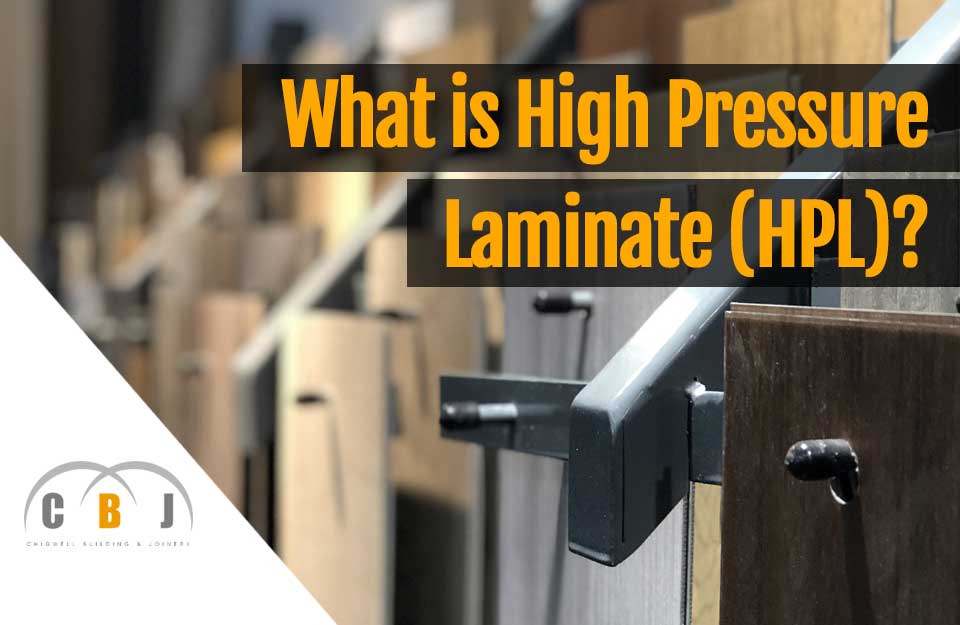News
What is High Pressure Laminate (HPL)?
Author Chigwell Building & Joinery
Date 08/03/2022
In the past, plastic laminate was very popular due to its various positive attributes.
Later, High Pressure Laminate (also known as HPL) was introduced to the market.
One can say that HPL is a descendant of the original plastic laminate as both have various things in common, but with some added benefits.
Read on to find out more, or use a jump link below to skip to a desired chapter:
Table of Contents
- What is HPL Board?
- How is High Pressure Laminate Made?
- Properties of HPL Board
- Types of High Pressure Laminates
- Typical Applications for High Pressure Laminate
- Conclusion
What is HPL Board?
High Pressure Laminate board is a decorative surface material which is considerably durable and resistant to wear.
HPL boards are also great in terms of their properties, as they are fire resistant and chemical resistant.
HPL is laminated to panels or boards by applying various adhesives.
Generally MDF or particle boards are used as they are considered to be ideal substrates due to their composition, stability and durability.
Some HPL can also be post-formed around the edges by applying heat.
High Pressure Laminate belongs to the high-tech group of high pressure decorative laminates.
The highly compact and aesthetically appealing composite sheet that results from the production process offers a highly resistant surface that is ideal for various applications.
How is High Pressure Laminate Made?
High Pressure Laminate is produced by saturating several layers of kraft paper with phenolic resin.
Afterwards, printed decor paper is placed over the kraft paper, and a pressing process commences.
Due to the heat and pressure applied, which exceeds 1000 PSI, the two become fused together.
Phenolic resin and melamine resin are thermoset plastics.
As a result, the curing process leads the resin to turn into plastic.
This happens due to a cross-linking process, whereby the paper sheets are converted into one laminated sheet which is considerably rigid.
This bonding process is strong and irreversible.
This is the main reason behind the durability of HPL boards.
Properties of HPL Board
The key properties of HPL boards are:
- Fire resistant.
- Heat resistant.
- UV resistant and stable to light, thus its colour will not change or fade over time.
- Moisture proof and infiltration resistant, as it is a highly hermetic product that prevents the penetration of water underneath the surface layer, making it a very stable option which is ideal to use when there could be environmental changes.
- Chemical resistant.
- Resistant to stains thanks to its surface consistency.
- Anti-static and so it does not attract dust.
- Durable and can withstand wear, including scratches, abrasions and impact.
- Decorative and aesthetically pleasing, as there are various colours and finishes available on the market.
- Easy to clean and virtually maintenance free.
- Can be used both for indoor and outdoor applications.
These are some of the reasons why HPL is considered to be a good choice when compared to other materials.
In recent years, Double Belt Press processes are used to produce Continuous Pressed Laminate (CPL).
This is a decorative paper that is impregnated with resins which have been fused together with high heat and pressure.
The thickness ranges between 0.4mm to 1mm, and they come in various lengths or in the form of a continuous roll.
Another variety is the Flexible CPL.
In this case, flexible thermosetting resins are impregnated in the decorative paper.
Like CPL, these are fused together by applying very high heat and pressure with resin-impregnated backers.
However, this type is intended for formable decorative laminates such as edge banding and profile wrapping.
The thicknesses are between 0.2mm and 0.4mm.
Types of High Pressure Laminates
There are various types or grades of HPLs.
They are intended for different uses and for particular performance requirements.
General Purpose HPL
General purpose is the most common and widely used HPL board.
They are used both for horizontal as well as vertical surface applications.
The thicknesses range between 0.71mm to 1.22mm.
Postforming HPL
These can be formed around the curved edges by applying high heat and restraint.
The maximum thickness of this type is around 0.97mm.
They can be formed to very small radii of as little as 9.5mm.
Backer HPL
This type of HPL is used for backing, so it doesn’t include a decorative surface.
It tends to be slightly thinner than the decorative HPL varieties.
Backer also includes the regrind, that is reclaimed HPL that has had the decorative sheet sanded off.
Special Purpose HPL
Special purpose HPLs include laminates that are chemical resistant, fire-rated and electrostatic dissipative.
An example is cabinetry liners which have these properties and are very high-wear.
In order to increase the resistance of particleboard or MDF, HPL can also be applied.
Hence it not only helps to improve the aesthetic appeal thanks to its decorative value, but it also improves the physical performance of the substrate.
For instance, a standard shelf made from particleboard can carry 45 lbs per square foot.
This same shelf is however able to hold 85 lbs if it’s overlaid with HPL.
Typical Applications for High Pressure Laminate
Considering the various positive properties and advantages of High Pressure Laminate (HPL), it is used in various applications and products, including:
- Furniture, especially cabinetry, to improve their aesthetic appeal.
- Flooring and wall treatments.
- Both horizontal and vertical surfaces, especially in high traffic areas such as in retail outlets, hospitals, clinics and hospitality settings.
- Bench tops, tables, counters and much more due to the high level impact resistance of HPL.
- The fact that it’s a non-porous surface and so easy to clean makes it ideal for applications where a high level of hygiene is necessary, such as laboratories, hospitals and kitchens.
- Suitable for contact with food as it is hygienic and heat resistant.
- Used both for residential as well as commercial applications.
Conclusion
With various colours and finishes to choose from, and offering a myriad of positive properties, HPL has become a very popular material.
It’s increasingly being used in a variety of applications, both indoors and outdoors.
Easy to clean and virtually maintenance free as it is highly durable and resistant, this material is a relatively recent innovation which is gaining considerable popularity.
One can safely conclude that it is a superior quality material which, thanks to its positive attributes, has gained a considerable advantage over traditional alternatives.


